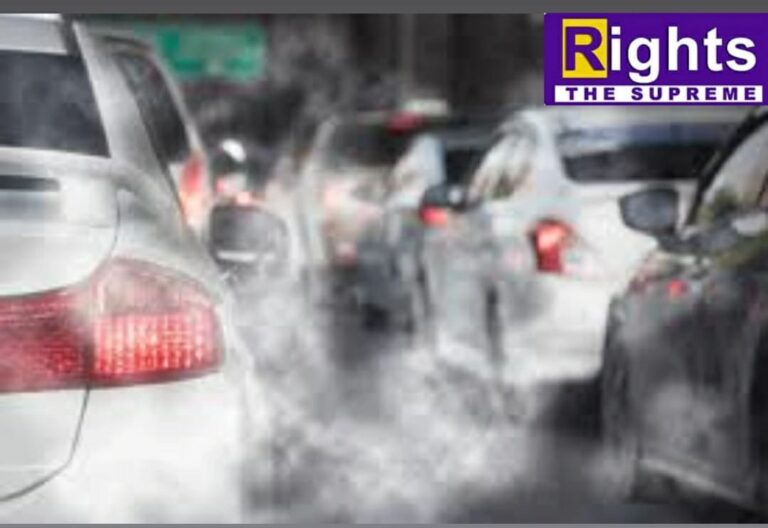Pollution Under Control Certificate: The Supreme Court has recalled its 2017 direction making a Pollution Under Control (PUC) certificate mandatory for third-party insurance.
Pollution under control certificate:
-
The Pollution Under Control (PUC) Certificate is a key document that vehicle owners in India must possess to legally drive or ride their vehicles.
-
It is issued by authorized emission testing centres after a thorough inspection of the vehicle's exhaust gas to ensure that emission levels are within permissible limits set by the government.
-
The PUC Certificate contains information such as the serial number, vehicle registration number, date of the test, validity period, test readings, and cost.
-
The certificate has a one-year validity for new vehicles, with regular tests required thereafter.
-
The testing criteria for the PUC Certificate include parameters like the manufactured year, carbon monoxide percentage, and hydrocarbon levels. Any vehicles exceeding the specified limits during testing will be reported to the relevant transport authorities.
-
To obtain a PUC Certificate, one can either visit an authorized emission testing centre or download it online through the M Parivahan portal.
Backgrounds of 2017 directives:
-
Context of the 2017 Order
-
Issuance: The directive was part of a broader effort to combat pollution in Delhi and was issued in August 2017.
-
Reason for the Directive: The order was passed on the recommendation of the Environment Pollution (Prevention and Control) Authority (EPCA), a statutory body that advises on environmental issues.
-
Requirement: The 2017 order mandated that a valid PUC certificate was necessary to renew a third-party insurance policy for vehicles. This was intended to ensure that only vehicles meeting emission standards could be insured, thereby reducing pollution.
Issues with 2017 directives:
-
Problems Highlighted by the General Insurance Council (GIC)
-
Insurance Coverage Impact: The General Insurance Council (GIC), argued that the directive had unintended negative consequences. About 55% of vehicles were not covered by insurance due to the PUC requirement.
-
Impact on Motor Accident Victims: The absence of insurance coverage made it difficult for victims of road accidents to receive compensation, as uninsured vehicles could not be covered for third-party liability.
-
Implementation Challenges
-
Linking PUC with Insurance: The directive linked PUC certificates with insurance renewal. Since PUC certificates are valid for only six months, this linkage caused issues when vehicles did not renew their PUC certificates on time. As a result, insurance policies could not be renewed, leading to a significant number of uninsured vehicles.
-
Lack of Hearing: GIC claimed that the order was passed without proper hearings from the insurance companies, which led to unintended consequences.
Supreme court's revised order :
-
Bench and Decision: The court acknowledged that strictly enforcing the 2017 order could have disastrous effects, such as leaving many vehicles without third-party insurance.
-
Modification of the Directive: The Supreme Court’s recent order effectively removes the requirement for a valid PUC certificate to renew a third-party insurance policy.
Legal implications:
-
For Insurance Companies and Vehicle Owners
-
Insurance Coverage: The removal of the PUC requirement for insurance renewal is expected to increase insurance coverage rates, thereby providing better protection for accident victims.
-
PUC Compliance: Vehicle owners are still required to maintain PUC certificates for compliance with emission standards, but the link between PUC and insurance renewal has been removed.
-
For Environmental Protection
-
Continued Efforts: The court's decision does not negate the importance of pollution control. It emphasizes that while ensuring vehicles are compliant with emission norms is important, it should not come at the expense of necessary insurance coverage.
-
For Future Regulations
-
Need for Comprehensive Solutions: The case highlights the need for comprehensive solutions that address both environmental concerns and practical challenges in the vehicle insurance sector.
Conclusion:
The Supreme Court’s decision to overturn its 2017 directive highlights the complex interplay between environmental regulations and practical issues in vehicle insurance. By removing the requirement for a valid PUC certificate for renewing third-party insurance policies, the court aims to balance the need for environmental protection with the necessity of providing adequate insurance coverage for motor accident victims.
Recent judgements:
-
The Supreme Court has recalled its 2017 direction making a Pollution Under Control (PUC) certificate mandatory for third-party insurance.
-
The Supreme Court on Friday abolished its own directive issued in 2017 that made a valid pollution under control (PUC) certificate mandatory for renewal of third-party insurance policy.
-
In an order passed by a bench headed by justice AS Oka, it was held: “If said direction is allowed to be implemented in letter and spirit, it will have disastrous consequences as some vehicles will continue to ply without third-party insurance.”
-
The order came on an application moved by the General Insurance Council (GIC) – an apex body of insurance firms – which highlighted the problem arising out of the implementation of apex court’s August 10, 2017 passed in the MC Mehta case relating to pollution in Delhi.
-
Revisiting its own order, the bench, also comprising justice Augustine George Masih said, “We are inclined to allow the application by deleting the aforesaid direction.” Solicitor general Tushar Mehta, representing GIC (General Insurance Council), submitted that the order of the court was proving detrimental for motor accident victims as nearly 55% vehicles do not have insurance cover. This posed great difficulty for victims seeking settlement of compensation claims in road accidents.
-
The 2017 order came to be passed when pollution levels in Delhi were on the rise and the court initiated drastic measures to keep it under control. In May this year, while issuing notice on the application, the court had said, “A right balance has to be struck that vehicles remain compliant with PUC norms and all vehicles must also have insurance cover.”
-
Senior advocate Aparajita Singh, assisting the court as amicus curiae, had held discussions with solicitor general to devise a way out to overcome the problem. On Friday, Singh supported the application moved by GIC to recall the earlier order.
-
The 2017 order was passed on the recommendation of the Environment Pollution (Prevention and Control) authority, or EPCA, a statutory body assisting the court on environment and pollution-related issues.
-
The 2017 order said, “It is made clear that the insurance companies will not insure a vehicle unless it has a valid PUC certificate on the date of renewal of insurance policy.” The GIC claimed that the order was passed without hearing it or any insurance companies. In February 2018, GIC moved an application for modification that was rejected by the SC registry on the ground that the application sought review of the top court’s order.
-
Challenging this order of rejection by SC registrar, GIC urged the apex court to consider its application as it raised an issue of “serious public importance”. Mehta, who has been representing GIC in this case, had said: “The resultant effect of this court’s order was that if there is no PUC, there will be no third-party insurance. This linking of PUC with annual insurance policy is creating problems. PUC is issued for six months and since they are not renewed, insurance policy cannot be renewed. This is affecting victims of accidents the most.”
-
Recently, the Supreme Court (SC) of India heard an application filed by the General Insurance Council referring to an order of the top Court delivered on August 10, 2017. The order stated that 100% compliance should be ensured by linking annual vehicle insurance with PUC (Pollution Under Control) certificates. During the proceedings, the learned Solicitor General appeared for the General Insurance Council and submitted that “…in view of this direction, 55% of the vehicles are not taking third-party insurance. Therefore, in the event of accident, claimants are finding it difficult to get compensation.” The bench constituting Justice Abhay S. Oka and Justice Ujjal Bhuyan observed “Prima facie, we are of the view that a right balance will have to be struck while ensuring that vehicles remain compliant with PUC norms. But at the same time, all vehicles must have a third-party insurance.” It further asked the Amicus Curiae and the learned Solicitor General (Tushar Mehta) to come out with a solution so that appropriate modification can be made to the order dated August 10, 2017. The SC bench listed the matter for hearing on July 15, 2024, and asked the Amicus Curiae and the learned Solicitor General to give suggestions in writing before the next date of hearing (July 15, 2024).
Impacts of the rulings:
The Supreme Court’s decision to recall its 2017 directive, which made a Pollution Under Control (PUC) certificate mandatory for renewing third-party insurance, has several significant impacts:
-
Increased Insurance Coverage: The ruling addresses the issue of a large number of vehicles being uninsured due to the difficulty or inconvenience of obtaining a PUC certificate. This change is expected to increase the number of insured vehicles, providing better financial protection for accident victims.
-
Compensation for Accident Victims: With more vehicles insured, victims of road accidents will have better access to compensation. Previously, many victims faced financial difficulties when involved in accidents with uninsured vehicles.
-
Balancing Pollution Control and Insurance: The court acknowledged the need to balance pollution control with ensuring that vehicles are insured. While the PUC requirement aimed to reduce vehicular pollution, it inadvertently led to a significant number of uninsured vehicles.
-
Use of Technology for Pollution Control: The court suggested the use of remote sensing technology to monitor vehicle emissions, particularly in high-pollution areas like Delhi-NCR. This approach aims to address environmental concerns without compromising insurance coverage.
References:

